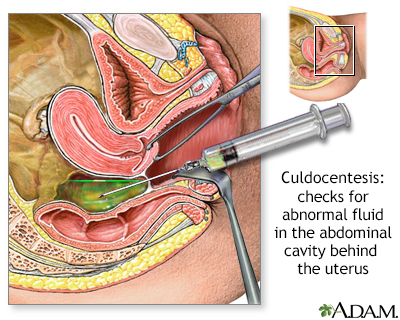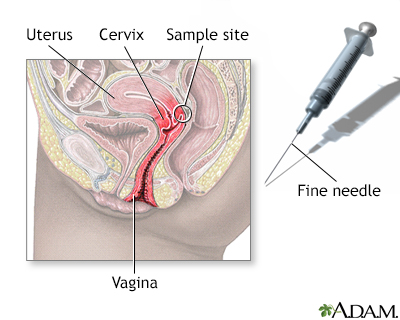Culdocentesis
Culdocentesis is a procedure that checks for abnormal fluid in the space just behind the vagina. This area is called the cul-de-sac.
Images



How the Test is Performed
First, you will have a pelvic exam. Then, the health care provider will hold the cervix with an instrument and lift it slightly.
A long, thin needle is inserted through the wall of the vagina (just below the uterus). A sample is taken of any fluid found in the space. The needle is pulled out.
How to Prepare for the Test
You may be asked to walk or sit for a short time before the test is done.
How the Test will Feel
You may have an uncomfortable, cramping feeling. You will feel a brief, sharp pain as the needle is inserted.
Why the Test is Performed
This procedure is rarely done today because a transvaginal ultrasound can show fluid behind the uterus.
It may be done when:
- You have pain in the lower abdomen and pelvis, and other tests suggest there is fluid in the area.
- You may have a ruptured ectopic pregnancy or ovarian cyst.
- Blunt abdominal trauma.
Normal Results
No fluid in the cul-de-sac, or a very small amount of clear fluid, is normal.
What Abnormal Results Mean
Fluid may still be present, even if not seen with this test. You may need other tests.
A sample of fluid may be taken and tested for infection.
If blood is found in the fluid sample, you may need emergency surgery.
Risks
Risks include puncturing the uterine or bowel wall.
Considerations
You may need someone to take you home if you were given medicines to relax.
Related Information
VaginaEctopic pregnancy
Ovarian cysts
References
Braen GR, Kiel J. Gynecologic procedures. In: Roberts JR, Custalow CB, Thomsen TW, eds. Roberts and Hedges' Clinical Procedures in Emergency Medicine and Acute Care. 7th ed. Philadelphia, PA: Elsevier; 2019:chap 57.
Eisinger SH. Culdocentesis. In: Fowler GC, ed. Pfenninger and Fowler's Procedures for Primary Care. 4th ed. Philadelphia, PA: Elsevier; 2020:chap 161.
Hur HC, Lobo RA. Ectopic pregnancy: etiology, pathology, diagnosis, management, fertility prognosis. In: Gershenson DM, Lentz GM, Valea FA, Lobo RA, eds. Comprehensive Gynecology. 8th ed. Philadelphia, PA: Elsevier; 2022:chap 17.
BACK TO TOPReview Date: 1/10/2022
Reviewed By: John D. Jacobson, MD, Department of Obstetrics and Gynecology, Loma Linda University School of Medicine, Loma Linda, CA. Also reviewed by David Zieve, MD, MHA, Medical Director, Brenda Conaway, Editorial Director, and the A.D.A.M. Editorial team.

Health Content Provider
06/01/2025
|
A.D.A.M., Inc. is accredited by URAC, for Health Content Provider (www.urac.org). URAC's accreditation program is an independent audit to verify that A.D.A.M. follows rigorous standards of quality and accountability. A.D.A.M. is among the first to achieve this important distinction for online health information and services. Learn more about A.D.A.M.'s editorial policy, editorial process and privacy policy. A.D.A.M. is also a founding member of Hi-Ethics. This site complied with the HONcode standard for trustworthy health information from 1995 to 2022, after which HON (Health On the Net, a not-for-profit organization that promoted transparent and reliable health information online) was discontinued. |
The information provided herein should not be used during any medical emergency or for the diagnosis or treatment of any medical condition. A licensed medical professional should be consulted for diagnosis and treatment of any and all medical conditions. Links to other sites are provided for information only -- they do not constitute endorsements of those other sites. © 1997- 2024 A.D.A.M., a business unit of Ebix, Inc. Any duplication or distribution of the information contained herein is strictly prohibited.
